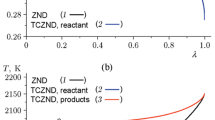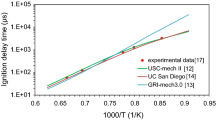Abstract
In recent years, several studies have been dedicated to modeling of detonations including assumptions of thermal non-equilibrium. Modeling using two-temperature models has shown that non-equilibrium affects detonation dynamics. However, the deployment of state-to-state models, one of the foremost non-equilibrium modeling tools, in detonation modeling remains under-explored. In this work, we detail the implementation of a STS model of \({\hbox {N}_{2}}\) and \({\hbox {O}_{2}}\) in a Zel’dovich–von Neumann–Döring reactor for a mixture of \({\hbox {H}_{2}}\)–air. Certain modifications to the usual theory and models must be performed before the deployment of aforementioned model, namely in the thermodynamics formulation. Additionally, since most codes are not compatible with STS models, a validation of an in-house code is carried out against CHEMKIN. Results indicate that the multi-temperature approach adopted in earlier works is likely not appropriate to model the internal distribution function of \({\hbox {O}_{2}}\) and therefore should be used with caution. A comparison of an estimated cell width with experimental values confirms the potential of the STS framework for a more accurate detonation modeling.







Similar content being viewed by others
Data availability
The datasets generated during and/or analyzed during the current study are available from the corresponding author on reasonable request.
References
Tarver, C.M.: Chemical energy release in self-sustaining detonation waves in condensed explosives. Combust. Flame 46(C), 157–176 (1982). https://doi.org/10.1016/0010-2180(82)90013-X
Tarver, C.M.: Chemical energy release in one-dimensional detonation waves in gaseous explosives. Combust. Flame 46(C), 111–133 (1982). https://doi.org/10.1016/0010-2180(82)90011-6
Tarver, C.M.: Chemical energy release in the cellular structure of gaseous detonation waves. Combust. Flame 46(C), 135–156 (1982). https://doi.org/10.1016/0010-2180(82)90012-8
Uy, K.C.K., Shi, L., Hao, J., Wen, C.Y.: Linear stability analysis of one-dimensional detonation coupled with vibrational relaxation. Phys. Fluids 32(12), 126101 (2020). https://doi.org/10.1063/5.0029468
Kadochnikov, I.N., Arsentiev, I.V.: Modelling of vibrational nonequilibrium effects on the \(\text{ H}_2\)–air mixture ignition under shock wave conditions in the state-to-state and mode approximations. Shock Waves 30(5), 491–504 (2020). https://doi.org/10.1007/s00193-020-00961-0
Voelkel, S., Masselot, D., Varghese, P.L., Raman, V.: Analysis of hydrogen–air detonation waves with vibrational nonequilibrium. AIP Conf. Proc. 1786, 070015 (2016). https://doi.org/10.1063/1.4967591
Shi, L., Shen, H., Zhang, P., Zhang, D., Wen, C.: Assessment of vibrational non-equilibrium effect on detonation cell size. Combust. Sci. Technol. 189(5), 841–853 (2017). https://doi.org/10.1080/00102202.2016.1260561
Lin, C., Luo, K.H.: Kinetic simulation of unsteady detonation with thermodynamic nonequilibrium effects. Combust. Explos. Shock Waves 56(4), 435–443 (2020). https://doi.org/10.1134/S0010508220040073
Uy, K.C.K., Shi, L., Wen, C.Y.: Numerical analysis of the vibration-chemistry coupling effect on one-dimensional detonation stability. Aerosp. Sci. Technol. 107, 106327 (2020). https://doi.org/10.1016/j.ast.2020.106327
Lino da Silva, M., Guerra, V., Loureiro, J.: Nonequilibrium dissociation processes in hyperbolic atmospheric entries. J. Thermophys. Heat Transf. 21(2), 303–310 (2007). https://doi.org/10.2514/1.26776
Silva, T., Grofulović, M., Terraz, L., Pintassilgo, C.D., Guerra, V.: Modelling the input and relaxation of vibrational energy in \(\text{ CO}_2\) plasmas. J. Phys. D Appl. Phys. 51(46), 464001 (2018). https://doi.org/10.1088/1361-6463/aadbd7
Sahai, A., Johnston, C.O., Lopez, B., Panesi, M.: Flow-radiation coupling in \(\text{ CO}_2\) hypersonic wakes using reduced-order non-Boltzmann models. Phys. Rev. Fluids 4(9), 93401 (2019). https://doi.org/10.1103/PhysRevFluids.4.093401
Chernyi, G.G., Losev, S.A., Macheret, S.O., Potapkin, B.V.: Physical and Chemical Processes in Gas Dynamics: Physical and Chemical Kinetics and Thermodynamics Volume II. American Institute of Aeronautics and Astronautics, Reston (2002). https://doi.org/10.2514/4.866753
Mcbride, B., Gordon, S., Reno, M.: Coefficients for Calculating Thermodynamic and Transport Properties of Individual Species. Nasa Technical Memorandum 4513(NASA-TM-4513), 98 (1993). https://ntrs.nasa.gov/citations/19940013151
Mcbride, B., Zehe, M.J., Gordon, S.: NASA Glenn coefficients for calculating thermodynamic properties of individual species: National Aeronautics and Space Administration. NASA Technical Paper 211556 (2002). https://ntrs.nasa.gov/citations/20020085330
Lopez, B., Lino da Silva, M.: SPARK: a software package for aerodynamics, radiation and kinetics. 46th AIAA Thermophysics Conference, Washington, DC, AIAA Paper 2016-4025 (2016). https://doi.org/10.2514/6.2016-4025
Davidenko, D., Mével, R., Dupré, G.: Reduced kinetic scheme for the simulation of detonation in \(\text{ H}_{2}\)–\(\text{ N}_{2}\text{ O }\)–Ar mixtures. Proc. Eur. Combust. Meet. 4, 6 (2009)
Born, M., Oppenheimer, J.R.: On the quantum theory of molecules. Ann. Physik 84, 458 (1927). https://doi.org/10.1142/9789812795762_0001
Anderson, J.J.D.: Elements of statistical thermodynamics. In: Hypersonic and High-Temperature Gas Dynamics, 2nd edn, pp. 501–558. American Institute of Aeronautics and Astronautics, Blacksburg (2006). https://doi.org/10.2514/4.861956
Silva, T., Grufolović, M., Klarenaar, B.L.M., Morillo-Candas, A.S., Guaitella, O., Engeln, R., Pintassilgo, C.D., Guerra, V.: Kinetic study of low-temperature \(\text{ CO}_2\) plasmas under non-equilibrium conditions. I. Relaxation of vibrational energy. Plasma Sources Sci. Technol. 27(1), 015019 (2018). https://doi.org/10.1088/1361-6595/aaa56a
Kosareva, A., Kustova, E., Mekhonoshina, M.: Simulations of \(\text{ CO}_2\) multi-temperature vibrational kinetics on the basis of new relaxation time models. J. Phys. Conf. Ser. 1959, 012030 (2021). https://doi.org/10.1088/1742-6596/1959/1/012030
Capitelli, M., Colonna, G., Giordano, D., Marraffa, L., Casavola, A., Minelli, P., Pagano, D., Pietanza, L.D., Taccogna, F.: Tables of internal partition functions and thermodynamic properties of high-temperature Mars-atmosphere species from 50 K to 50000 K. Technical Report 246, European Space Agency (Scientific and Technical Reports) ESA STR (2005)
LinodaSilva, M., Guerra, V., Loureiro, J.: State-resolved dissociation rates for extremely nonequilibrium atmospheric entries. J. Thermophys. Heat Transf. 21(1), 40–49 (2007). https://doi.org/10.2514/1.24114
Lino da Silva, M., Lopez, B., Guerra, V., Loureiro, J.: A multiquantum state-to-state model for the fundamental states of air: the Stellar database. In: Ouwehand, L. (Ed.) 5th International Workshop on Radiation of High Temperature Gases in Atmospheric Entry, ESA SP, vol. 714, p. 16 (2012)
Arsentiev, I.V., Loukhovitski, B.I., Starik, A.M.: Application of state-to-state approach in estimation of thermally nonequilibrium reaction rate constants in mode approximation. Chem. Phys. 398(1), 73–80 (2012). https://doi.org/10.1016/j.chemphys.2011.06.011
Annaloro, J.: Modèles collisionnels-radiatifs appliqués aux situation d’entrée atmosphérique martienne et terrestre. PhD Thesis, Univeristé Rouen (2013)
Kunova, O., Kustova, E., Savelev, A.: Generalized Treanor–Marrone model for state-specific dissociation rate coefficients. Chem. Phys. Lett. 659, 80–87 (2016). https://doi.org/10.1016/j.cplett.2016.07.006
Qéméner, G., Kendrick, B.K., Balakrishnan, N.: Quantum dynamics of the \(\text{ H }+\text{ O}_2\rightarrow \text{ O }+\text{ OH }\) reaction. J. Chem. Phys. 132, 014302 (2010). https://doi.org/10.1063/1.3271795
Davidenko, D., Mével, R., Dupré, G.: Numerical study of the detonation structure in rich \(\text{ H}_2\)–\(\text{ NO}_2/\text{N}_2\text{ O}_4\) and very lean \(\text{ H}_2\)–\(\text{ N}_2\text{ O }\) mixtures. Shock Waves 21, 85–99 (2011). https://doi.org/10.1007/s00193-011-0297-z
Mével, R., Gallier, S.: Structure of detonation propagating in lean and rich dimethyl ether–oxygen mixtures. Shock Waves 28, 955–966 (2018). https://doi.org/10.1007/s00193-018-0837-x
Chatelain, K.P., He, Y., Mével, R., Lacoste, D.A.: Effect of the reactor model on steady detonation modeling. Shock Waves 31, 323–335 (2021). https://doi.org/10.1007/s00193-021-01022-w
Lee, J.H.S.: The Detonation Phenomenon. Cambridge University Press, Cambridge (2008). https://doi.org/10.1017/CBO9780511754708
Treanor, C.E., Rich, J.W., Rehm, R.G.: Vibrational relaxation of anharmonic oscillators with exchange-dominated collisions. J. Chem. Phys. 48(4), 1798 (1968). https://doi.org/10.1063/1.1668914
Ng, H.D., Ju, Y., Lee, J.H.S.: Assessment of detonation hazards in high-pressure hydrogen storage from chemical sensitivity analysis. Int. J. Hydrog. Energy 32(1), 93–99 (2007). https://doi.org/10.1016/j.ijhydene.2006.03.012
Ciccarelli, G., Ginsberg, T., Boccio, J., Economos, C., Sato, K., Kinoshita, M.: Detonation cell size measurements and predictions in hydrogen–air–steam mixtures at elevated temperatures. Combust. Flame 99(2), 212–220 (1994). https://doi.org/10.1016/0010-2180(94)90124-4
Stamps, D.W., Tieszen, S.R.: The influence of initial pressure and temperature on hydrogen–air–diluent detonations. Combust. Flame 83(3–4), 353–364 (1991). https://doi.org/10.1016/0010-2180(91)90082-M
Guirao, C.M., Knystautas, R., Lee, J.H., Benedick, W., Berman, M.: Hydrogen–air detonations. Symp. Int. Combust. 19(1), 583–590 (1982). https://doi.org/10.1016/S0082-0784(82)80232-4
Kaneshige, M., Shepherd, J.E.: Detonation database. Technical Report FN97-8, GALCIT. Technical Report (1997). https://shepherd.caltech.edu/detn_db/html/db.html Accessed 5 Dec 2020
Sahai, A.: Reduced-order modeling of non-Boltzmann thermochemistry and radiation for hypersonic flows. PhD Thesis, University of Illinois at Urbana-Champaign (2019)
Viegas, P., Van De Sanden, M.C.M., Longo, S., Diomede, P.: Validation of the Fokker–Planck approach to vibrational kinetics in \(\text{ CO}_2\) plasma. J. Phys. Chem. C 123(37), 22823–22831 (2019). https://doi.org/10.1021/acs.jpcc.9b06576
Acknowledgements
The authors would like to thank F. Weng from Tsinghua University and the SPARK development team for assistance in developing the required code to carry out this work. This work was funded by the King Abdullah University of Science and Technology through the baseline Fund BAS/1/1396-01-01.
Author information
Authors and Affiliations
Corresponding author
Ethics declarations
Conflict of interest
The authors have no financial or proprietary interests in any material discussed in this article.
Additional information
Communicated by G. Ciccarelli.
Publisher's Note
Springer Nature remains neutral with regard to jurisdictional claims in published maps and institutional affiliations.
Rights and permissions
Springer Nature or its licensor (e.g. a society or other partner) holds exclusive rights to this article under a publishing agreement with the author(s) or other rightsholder(s); author self-archiving of the accepted manuscript version of this article is solely governed by the terms of such publishing agreement and applicable law.
About this article
Cite this article
Vargas, J., Mével, R., Lino da Silva, M. et al. Development of a steady detonation reactor with state-to-state thermochemical modeling. Shock Waves 32, 679–689 (2022). https://doi.org/10.1007/s00193-022-01105-2
Received:
Accepted:
Published:
Issue Date:
DOI: https://doi.org/10.1007/s00193-022-01105-2




